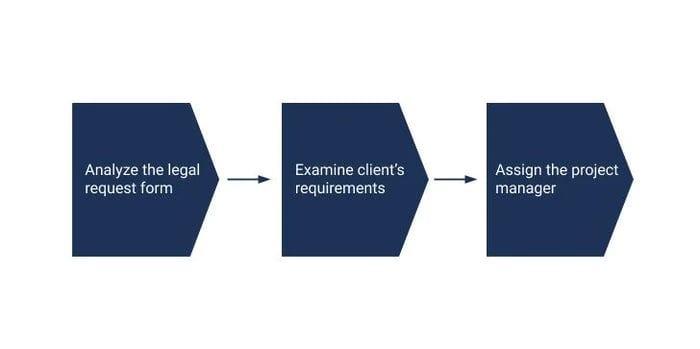Legal Project Management: the Ultimate Guide to Boosting Efficiency

As any lawyer who has taken on a massive legal project will tell you, a touch of planning goes a long way. On a mission to deliver the best service to their clients, the best law firms are starting to use legal project management to manage legal cases and deliver better results to their clients.
Legal project management means applying project management techniques in a legal context to develop a particular service or product. It is all about planning a project ahead of schedule, monitoring the project once it is underway and reviewing it upon completion.
The fundamentals of legal project management
Legal project management comes with a number of core components to deliver a successful project:
- Plan project in advance
- Monitor the progress of ongoing projects
- Manage project progress
- Communicate the progress of projects to key stakeholders
- Confirm project completion
- Review project outcomes after completion
What sets legal project management apart from universal project management is that it is explicitly developed with legal processes like litigation in mind. It is emerging as a key discipline for lawyers to specialize in with many law firms expecting lawyers to have a strong knowledge of project management.
In an economy where inefficient processes cost law firms thousands, agile management of cases and projects equips lawyers with the tools to examine the scope of projects before launching them.
Why Do I Need Legal Project Management?

There are many reasons to use this tactics to complete your legal projects. From reducing the stress level and achieving simple organization to improved results, risk management, and cost-cutting, it delivers many substantial benefits.
"Viewing cases as projects has a number of critical advantages for law firms. These include better organization, standardization of operations, increased insight for management, reduction of errors, and more predictability when it comes to revenue." (Larry Port, CEO of Rocket Matter & of co-author of “The Lean Law Firm bestseller book)
Below are some of the reasons you need to incorporate project management:
Better Project Results
The more thorough your planning and project management process is, the better your results will be.
Outlining the client's goals and methodically working towards them enables you to deliver better results to clients than you would have been able to without a clear strategy.
Risk Management
Planning out projects from start to finish ensures that legal professionals understand the needs of clients and communicate all the necessary information throughout the project.
With the right project management process, insurance and compliance projects become much easier to manage and dramatically reduces the risk of malpractice.
Cuttiing Costs
Legal projects are expensive, and increasing the efficiency of projects will help to push down costs.
Creating a project management strategy gives you the tools you need to break down and manage a project to deliver the best results. Without proper management, projects become can resource intensive as inefficiency takes place.
Better Predict Task Timelines and Deliverables
Noting down all the deliverables and setting down a realistic timeframe for their delivery allows you to predict most aspects of a project.
For example, you can predict how long the project will take to complete, the obstacles you will face and the amount of profit you will take away from the project before finishing the project.
The Four Stages of Legal Project Management
Generally, in any legal project management strategy, there are four main stages; intake, planning, execution and review. These stages can be defined as follows:
- Intake - Launch a new project, set goals and allocate resources
- Planning - Define client requirements, measure the scope of the project, develop objectives, decide timeline and allocate a budget
- Execution - Monitor the project from start to finish, track use of physical and financial resources, draw up a schedule and monitor the outcome of tasks
- Review - Assess how successful the project was, look for areas to improve and implement the necessary changes for future projects
Intake

Typically a new project begins once a client has submitted a legal request form.
The legal request form is a document that describes the problem that needs to be solved, the client’s desired outcome and their expected timetable for the project.
After reading the legal request form, the in-house team can start to examine the client’s requirements and consider how to achieve the client's goals.
The document will provide you with the information you need to determine the scope of the project.
Outlining the scope of work in advance is advantageous because it provides you with information that you can use to flesh out the rest of your plan (including the potential cost of the project).
Now it is critical to assign an in-house lawyer to manage the project to make sure that the client has a point of contact who is aware of the project’s progress.
The primary lawyer helps to deliver open communication and guarantee that the project's progress is in line with the client’s needs.
Planning

Now that the basics of the project have been jotted down, it is time to start planning out the specifics. The plan defines what needs doing and who is going to do it.
The first thing you need to do is evaluate the client’s requirements and decide whether to complete the project internally or with the assistance of outside counsel.
To make an informed decision you can use an Outside Counsel Qualification Checklist that takes into account whether the risk, complexity, and resource requirements of the project require external counsel.
If you choose to work alongside external counsel, then they should be fully briefed on the project’s requirements.
However, if you decide to manage a project in-house, then building a proposed plan is the next step. When submitting a plan, catalog each task in the project, who will complete it and how long it will take to complete. You should also make a note of the cost required to complete each task.
Once you have a proposal, evaluate it and consider if there are any changes you can make to complete processes more efficiently. If the proposed plan is ready to be implemented, all relevant staff require a statement of work, including the plan, project scope and costs of completing the project.
Execution
.webp?width=700&height=444&name=Untitled%20drawing%20(1).webp)
After developing the plan, it is time to start implementing it. The key to successfully executing a project is making sure that you don’t stray from the plan you’ve set out.
Monitor the status of tasks throughout the project to stay on target with the client's schedule and requirements.
Throughout execution, you will need to pay attention to any risks that are rising during the process. Within the project, factors like scope creep, need to be monitored relentlessly. Likewise, if there is a difference between predicted cost and actual cost, this needs to be flagged and addressed asap.
A great way to oversee a project is to schedule monthly project status meetings to discuss a project’s development and assess whether there any risks you need to address.
If you want to go the digital route, then you can use a digital legal project management tool (see further below) to collaborate with your team and share documents online. Many project management platforms have dashboard views where you can see the progress of tasks at a glance.
Review
.webp?width=700&height=349&name=Step%20One%20(1).webp)
The moment you complete the project it is time to look back at what you do better in the future. Many law firms make the mistake of overlooking this phase due to time constraints or moving on to the next project.
However, evaluating the project is essential for making improvements for subsequent cases.
At the very least the lawyer assigned to the project and the client should assess the results, and evaluate its successes and failures. Ideally, this should be done within the first 45 days after completion of the project so you can discuss the project with a fresh mind.
The best reviews will evaluate ways to improve the project management process for the next project. For instance, if the intake stage failed to outline specific goals for the project, then this should be taken into account in the review.
Then you can make it an objective to improve the intake stage and draw up more specific goals in future projects.
The Role of LegalTech in Project Management
The increase in the use of legal project management has meant there are more project management tools than ever before for law firms to call on. Legaltech for project management ranges from tools that create project templates to customizable plans and dashboards.
For example, Bigle Legal is a legal document automation platform that allows you to create and manage documents through one user interface.
Having all of this information in one place makes it much easier to prepare the necessary documents and verify the project is on target for delivery. Digital signatures also make it easy to sign off on documents and pass them to the client promptly.
On the other hand, tools like Redbooth focus emphasize collaboration with tasks that can be prioritized and onboard video conferencing capabilities.
Incorporating digital tools into legal project management is an excellent way to manage projects more efficiently. The traditional approach of sending documents and emails back and forth limits the collaborative process.
Legal Project Management: Better Service, Better Results
Clearly defined legal project management is essential for providing a first-rate experience to clients.
Planning projects in advance, collaborating with other lawyers and proactively managing projects will ensure you deliver projects with superior results.Taking the time to catalog your client’s requirements and systematically fulfilling them situates you as a leading law firm.
In a saturated legal market, project management has become a competitive differentiator for many firms. Deploying a project management strategy ensures that you can compete and with other firms deliver a cost-effective service that keeps clients coming back for more.
Request info! Accelerate your law firm or legal department with document automation. Find out more about Bigle Legal platform.
 By
By
.webp?width=500&height=263&name=circler-min%20(1).webp)


